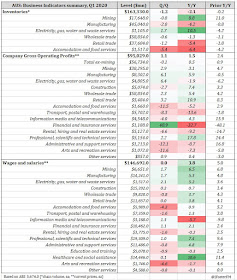Business Indicators — Q1 | By the numbers
- Inventories fell by 1.2% in Q1 to $163.3bn against an expected fall of 0.6% (prior 0.3%). This was the sharpest quarterly fall since Q4 2014, while in annual terms inventories declined from -0.2% to -2.1% to be at their weakest going back to Q4 2010.
- Company gross operating profits lifted by 1.1% to $95.029bn in Q1, coming in ahead of the 0.5% lift anticipated and after a 3.5% fall in Q4 last year. The annual pace pulled back from 2.4% to 1.5%.
- Wages and salaries flatlined in the quarter, slowing sharply from a 1.1% rise in the previous quarter, as annual growth decelerated to 3.8% from 5.0%.
Business Indicators — Q1 | The details
The sharp run down in inventories (-1.2%) in the March quarter was largely anticipated as firms were hit by an unprecedented surge in demand for essential goods ahead of the April COVID-19 lockdown in Australia. Reflecting this were falls in inventories across wholesalers (-0.6%), retail (-1.2%) and manufacturing (-2.0%). Firms in accommodation and food services also appeared to be keen to clear stock (-5.4%) ahead of the implementation of social distancing measures.
Company gross profits in headline terms lifted by 1.1% in Q1, though annual growth slowed from 2.4% to 1.5% — its weakest pace since Q3 2016. The national accounts use a different accounting treatment for company profits, which abstracts for changes in the value of inventories. In Q1's case, the ABS reported an inventory valuation adjustment from quarter to quarter of $1.633bn. Adjusting gross profits for this, company profits declined by 0.6% in the March quarter.
Looking across the main details, mining profits advanced by 2.9% in Q1 (3.1%yr) against softness from non-mining firms -0.1% (0.5%yr).
Company gross profits in headline terms lifted by 1.1% in Q1, though annual growth slowed from 2.4% to 1.5% — its weakest pace since Q3 2016. The national accounts use a different accounting treatment for company profits, which abstracts for changes in the value of inventories. In Q1's case, the ABS reported an inventory valuation adjustment from quarter to quarter of $1.633bn. Adjusting gross profits for this, company profits declined by 0.6% in the March quarter.
Wages and salaries were flat in Q1, which is the weakest outcome in a single quarter since Q4 2016, while annual growth was lowered from 5.0% to 3.8% to its slowest since Q3 2017. This figure is driven by employment and hours worked, so clearly a very large contraction will be ahead in Q2. Note that the detail in the summary table (above) highlighted significant weakness for wages in arts and recreation (-4.6%qtr) and accommodation and food services (-4.2%qtr), which are two of the hardest-hit sectors by COVID-19 disruptions.
Business Indicators — Q1 | Insights





